|
|
Possible paintings
for the
2007 calendar None of them have appeared before. |
|
CLICK |
The first painting in each group is the one I prefer. Sometimes I will give my reasons. You do not have to choose the one I like. I do prefer to use only one painting per artist, and that most (say 10) of the paintings be a horizontal format. I have to have a painting in the calendar by Mario Gonzalez Chavajay and by Pedro Rafael Gonzalez Chavajay. |
| Antonio Coche Mendoza | |
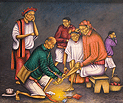 |
|
| El Curandero, Atitlan, 1990, 20" x 24" | |
| Mariano Gonzalez Chavajay | |
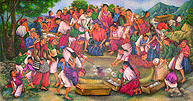 |
|
| 1. Exhumacion,
2005 40" x 75".
A short segment on an exhumation in Guatemala appeared (12/29/05) on the Newshour on PBS. |
|
| . | Mario Gonzalez Chavajay |
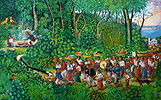 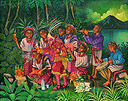 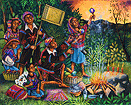 |
|
| 1. Mal tioxinem tre ka jaw (Acción
de gracias a dios)(Giving thanks to the creator). 2003. 40"
x 60". This is Mario's largest and most carefully done
painting.
2 Ajq'iij Maya (Maya day keeper). 2005. 16" x 20". 3. Hacedores de lluvia (Rain makers). 2005. 16" x 20". Both of these last paintings unfortanately were painted on a heavily textured cloth. I do not yet know if this will interfere with a good reproduction. |
|
| . | Domingo Garcia Criado |
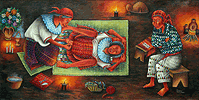 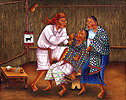 |
|
| 1. Parto (Childbirth). 2004.
17" x 34".
2.El Dentista. 1999. 16" x 20". |
|
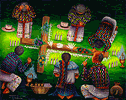 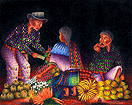 |
|
| 3. Adoración de la cruz de
Semana Santa ( Blessing the cross during holy week). 2002. 16" x
20"
4. Vendiendo frutas. Selling fruit. 2000. 16" x 20". |
|
| Matias Gonzalez Chavajay | |
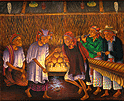 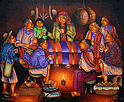 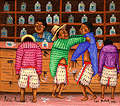 |
|
| 1. Baile de la cofradía
(Dance of the religious society). 1992. 20" x 24"
2. La Pedida (The request). 1999. 18" x 22". This painting the boy's family is visiting the girl's family to request her hand in marriage. 3. Los bolos (the drunks). 1988. 7" x 8". |
|
 |
|
| 4. Baile de Conquista, Sololá (Dance of the Conquest, Sololá). 1990. 20" x 16". Although this is entitled Baile de Conquista, it really is the Baile Mexicano. | |
| Lorenzo Gonzalez Chavajay | |
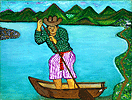 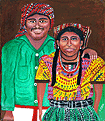 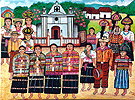 |
|
| 1. Paisaje (Landscape).
9" x 11". 1990. This painting best captures how the
Tz'utuhil fishermen are. Lorenzo is at once the most modern of the
Tz'utuhil artists, and at the same time the most naive.
2. Una pareja alegre (A happy couple). 1991. 14" x 12". To me this painting most clearly represents the warm affection you often encounter in a Maya couple. 3. Processión, Santa Catarina Ixtahuacan. 1993. 22" x 29". The patterns of the ceremonial huipiles of the texeles are particularly beautiful. |
|
| Pedro Miguel Reanda Petzey: | |
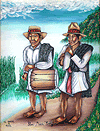 |
|
| 1. Musicos de Atitlan. 1990. 19" x 15". Although quite naive, there is a compelling quality about this painting. | |
| Diego Isaias Hernandez Mendez: | |
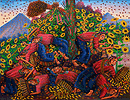 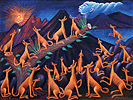 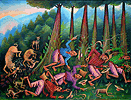 |
|
| . | 1. El fracaso de las Texeles
(The de failure of the texeles). I like this one because
besides the humorous encounter with the bee hive, it depicts the women
of the cofradia gathering flowers.
2. Senales de lobos viendo el tiempo bueno o malo) Wolves signaling their siting of good or bad weather. 2004. 20" x 26". Although no Maya are in this painting, it does show the closeness of the Maya world to nature and animals. 3. El fracaso de los casadores (The defeat of the hunters). 2003. 20" x 26". I like it that the hunters are beaten by the animals. |
| Paula Nicho Cumes | |
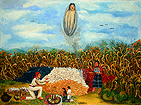 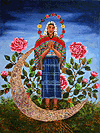 |
|
| 1. Juk'ux Je'el (Corazon del
Maiz) (Spirit of corn). 2002. 18" x 24"
2. Nana Luna (Grandmother moon). 2002. 24" x 18". |
|
| Antonio Ixtamer | |
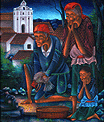 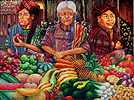 |
|
| 1. Pascual Abaj (Holy rock).
1990. 18" x 15". Of all the paintings that have passed
through my hands, this painting for me most clearly represents the
condition of the Maya people for the last 500 years. Dominated by the
Spanish culture, they preserved their own traditions in secret, in
this case in a forest under the cover of darkness.
2. Las cuatro edades (The four ages). 1994. 38" x 51". |
|
| Pedro Rafael Gonzalez Chavajay | |
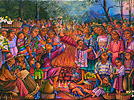 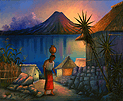 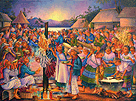 |
|
| 1. Presentación de niños
(Presentation of children). 2004. 30" x 40".
2. Atartdecer en Atitlán (Evening in Atitlán). 2005. 9" x 11" 3.Consegración de Maiz (Consecration of the corn). 2005. 30" x 40". |
|
| Rosa Elena Curruchich | |
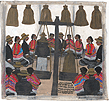 |
|
| 1. Estan pesando trigo, el senor pesa un quintal (Weighing flour, the man weighs 100 pounds). 1991. 5" x 5". Rosa, one of the granddaughter of Andres Churruchich died last year. She always painted these very small paintings. This is the only painting of hers that I have in the US (I have one in Guatemala if I could get it quick enough), but I know a woman who has others by her. I think it would be good to use two, side by side, actual size. | |
| Victor M. (semi anonymous) | |
 |
|
| 1. Conflicto. This artist is from San Juan Comalapa. Notice the figure of death inside the house. | |
| Rafael Gonzalez y Gonzalez | |
| . | 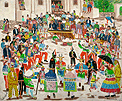 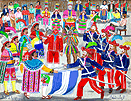 |
| 1. Baile de venados (Deer
dance). Ca. 1980. 20" x 24". This shows the San Pedro of
Rafael's childhood, before 1950.
2. Baile de Conquista (Dance of the Conquest). Ca 1989. 16" x 20". This is the real dance of the conquest, unlike Matias (#4). It has the same red shaman as Mario's (#2) and might be good to use in conjunction with it. Before the dance is performed the actor who acts as the ajq'iij goes into the forest to ask the spirit to possess him during the performance. |
|
| Juan Sisay | |
| . |   |
| 1. Sanguijuelas (Leeches).
1960. 10" x 12".
2 Cofrade. Ca 1970. 14" x 12". Juan Sisay was the first artist in Santaigo Atitlan, and the most famous of all the Tz'utuhil artists. He was assassinated by the death squads in 1989. |
|
| Victor Vasquez Temó | |
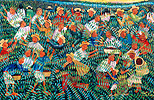 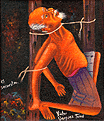 |
|
| 1. Corte de café. 1993.
25" x 37".
2. El Secuestro. 1996 7" x 6". This painting, although tiny, captures the horror of torture. |
|
|
To contact us write: Arte Maya Tz'utuhil, P.O. Box 40391, San
Francisco, CA 94140. Telephone: (415) 282-7654.
Email me at
All paintings and photographs Copyright © 1988–2015 Arte Maya Tz'utuhil |